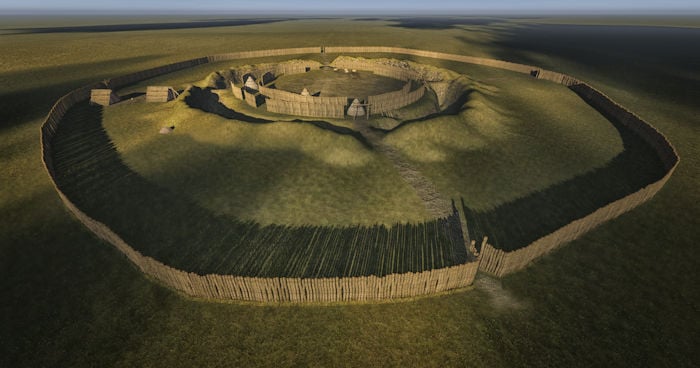
A mysterious, newly discovered stone roundel in Prague is older than Stonehenge and the Egyptian pyramids, built some 7,000 years ago during the Stone Age. Its purpose remains unknown.
“Roundels are the oldest evidence of architecture in all of Europe,” Jaroslav Řídký, of the Institute of Archaeology of the Czech Academy of Sciences, told Radio Prague International.
The circular Neolithic structure measures a massive 180 feet across—as wide as the Leaning Tower of Pisa is tall—and has three entrances. Construction workers first discovered the historic roundel in the 1980s, while installing gas and water lines on the outskirts of the city in the district of Vinoř.
It has only now been unearthed in its entirety, revealing the remnants of its wooden palisade, or defensive wall, surrounding the structure.
Archaeologists excavating the Stone Age roundel on the outskirts of Prague. Photo courtesy of the Institute of Archaeology of the Czech Academy of Sciences.
“Roundels were built during the Stone Age, when people had not yet discovered iron. The only tools they could use were made of stone and animal bones,” Miroslav Kraus, who oversaw the excavation, told Radio Prague International. “It could have been used as an economic center, a center of trade. It could also have been a center of some religious cult, where rites of passage or rituals connected to the time of year were performed.”
Little is known about the people who built the roundel, but they were part of Stroked Pottery culture, active from about 4900 B.C.E. to 4400 B.C.E., Řídký told Live Science.
The same people, who lived in communal lodges in farming villages, built other roundels in the Czech Republic’s Bohemia region. Some 200 examples of the architectural form have been spotted across Central and into Eastern Europe, with Germany’s Goseck Circle, the oldest one ever found, dating to 4900 B.C.E. Aerial drone photography has helped researchers identify other roundel examples in recent decades.
Digs at the newly excavated roundel revealed pottery fragments, animal bones, and stone tools in the ditch fill. Archaeologists are hopeful that carbon dating can help teach us more about the structure, pinpointing a more exact construction date and determining whether it is connected to a nearby Neolithic settlement.
So far, radiocarbon tests on samples from the structure have narrowed the time period in which it was built to 4900 B.C.E. to 4600 B.C.E. That’s the entirety of the known period when roundels were built, after which they disappeared from the historical record just as mysteriously as they had entered.
See more photos of the Vinoř roundel below.
An aerial view of the Vinoř roundel near Prague. Photo courtesy of the Institute of Archaeology of the Czech Academy of Sciences.
Excavations of the Stone Age roundel on the outskirts of Prague. Photo courtesy of the Institute of Archaeology of the Czech Academy of Sciences.
Excavations of the Stone Age roundel on the outskirts of Prague. Photo courtesy of the Institute of Archaeology of the Czech Academy of Sciences.
Excavations of the Stone Age roundel on the outskirts of Prague. Photo courtesy of the Institute of Archaeology of the Czech Academy of Sciences.